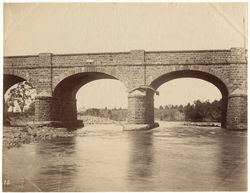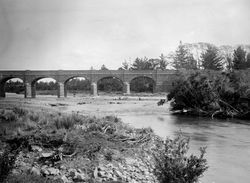The bridge
It soon became clear that a bridge was necessary. This was moslty for two reasons. First, the amount of traffic justified. Second, the punt was unreliable - both because of weather and difficulties with the punt operators.
The old Perth Bridge, a vital link between North and South, had its tragedies as well as its moments of grandeur. It was mooted as early as 1826. In 1835 a meeting was held at the first hotel, St Andrew's Inn, with a view to bringing about the erection of a bridge. The stone for the original structure came from the side of the hill not far from the Tabernacle. Lieutenant William Kenworthy was the first supervisor of the prisoners called to work on the structure. Mr James Purves was superintendent of bridge works.
The original cost was £10,000, and then when Captain Alexander Cheyne took over as Director of Road Works in 1837, work was begun embodying alterations, which increased the cost. The length was extended to 900 feet, and the price was estimated at £20,000. It was completed in 1839, only to be damaged in 1840-41, part of the retaining wall giving way. In the time of Sir William Denison, as Lieutenant Governor, in 1852 the bridge was so severely damaged that a new suspension iron bridge was ordered from England. This, however, was to be sold to Sydney for £5,000, and the reconstruction of the old bridge undertaken, with Sir William Denison visiting Perth and staying at the Perth Hotel to watch the works in progress, being an engineer himself.
The bridge was destroyed by the great flood of March 1929, and the present one was erected in 1931 under the supervision of Mr G.D. Balsille, Director of Public Works. There was a fatal accident at the bridge, not long afterwards, when a truck crashed over the structure, dropping 34 feet: two men were killed. A few months later, two men in a car crashed and the driver was killed. In 1956 seven floods struck the bridge. The area near the bridge was the scene of the early Perth Regattas, held on the waterfront down from the old cemetery. As many as 6,000 persons attended. Paired oared craft as well as foot races were on the pro- gramme. A highlight was a pig in a box to be retrieved from the end of a greasy pole.
Most of the streets of Perth were laid out in 1833. The route of the Highway was finally resolved with the building of the bridge in 1837-39.
Reference: Rait, B. 1971 'Perth and its story', Advance Publicity Co, Hobart.
Early bridge designers apparently lacked the means to make an arch of wide span, but trusted to heavy masses of masonry, occupying a large part of the waterway, with smaller arches alongside or between them. The result was that in flood time the river was dammed about the bridge which increased the scour at the base up of the piers and so in time tended to defeat the very object of heavy piers and to make the whole bridge insecure. It was largely this fault which lost us the superlative bridge at Perth in the floods of 1929. The heavy piers collapsed beneath the pressure of logs and water.
Reference: Sharland, M. 1952 'Stones of a Century', J. Walch & Sons, Hobart, p 11.




















